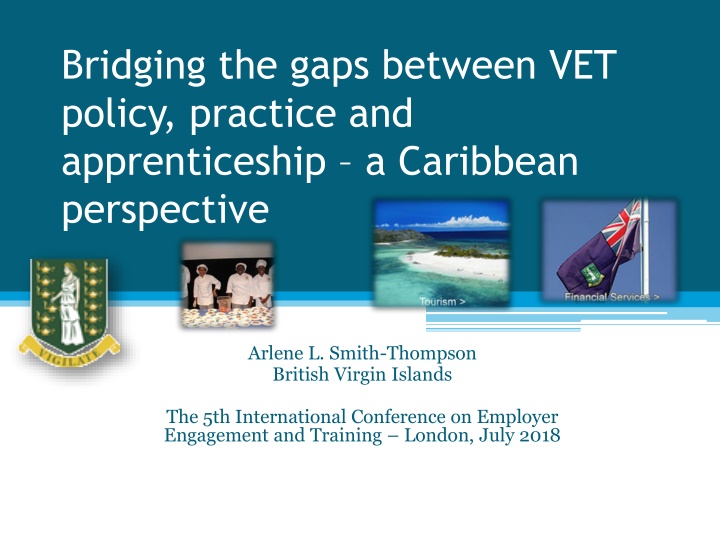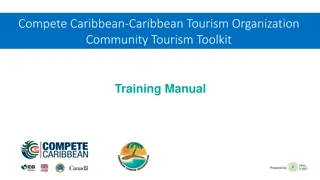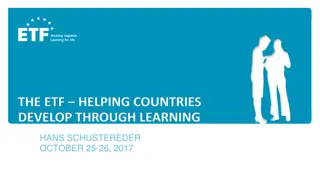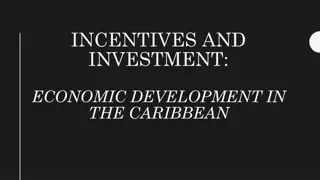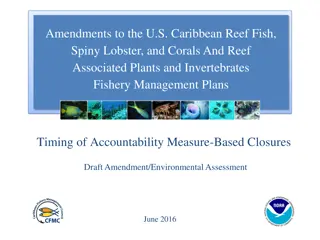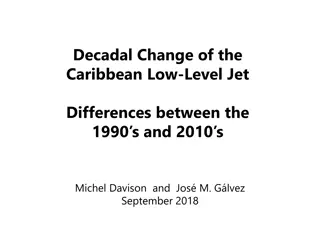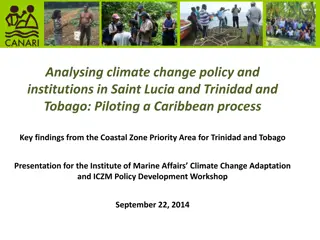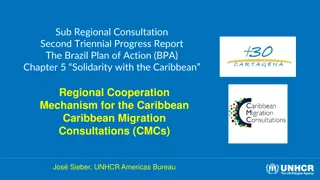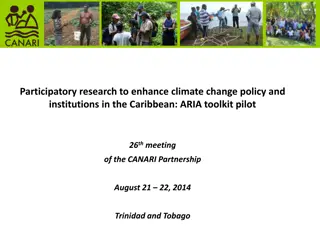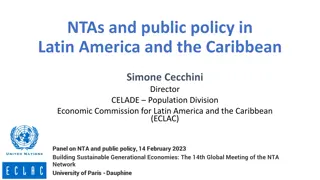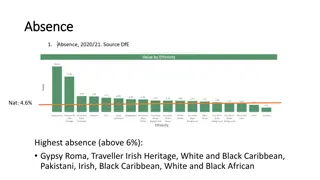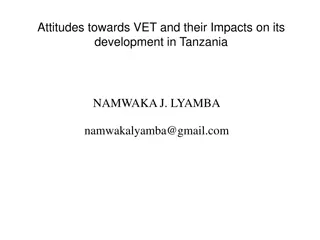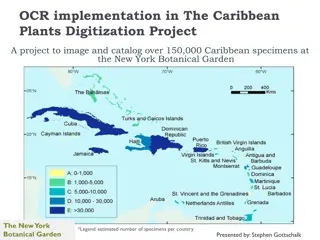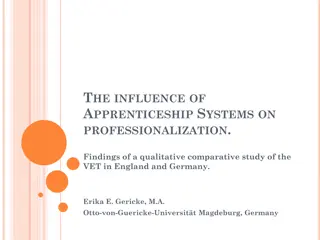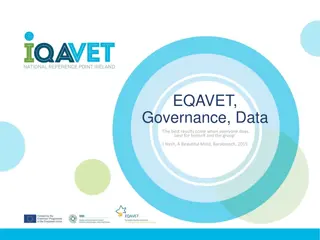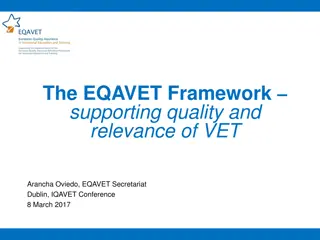Bridging VET Policy and Practice: A Caribbean Perspective
British Virgin Islands, a country with a focus on financial services and tourism, faces gaps in VET policy, practice, and apprenticeship programs. Challenges post-Hurricane Irma recovery further complicate the situation. Recent research highlights the need to align VET programs with employer needs, especially at tertiary levels, to enhance outcomes. The traditional Caribbean approach to VET involves providing alternative education tracks and limited sustained apprenticeship opportunities. This necessitates a shift toward a more comprehensive preparation combining institutional and work-based settings.
Download Presentation

Please find below an Image/Link to download the presentation.
The content on the website is provided AS IS for your information and personal use only. It may not be sold, licensed, or shared on other websites without obtaining consent from the author.If you encounter any issues during the download, it is possible that the publisher has removed the file from their server.
You are allowed to download the files provided on this website for personal or commercial use, subject to the condition that they are used lawfully. All files are the property of their respective owners.
The content on the website is provided AS IS for your information and personal use only. It may not be sold, licensed, or shared on other websites without obtaining consent from the author.
E N D
Presentation Transcript
Bridging the gaps between VET policy, practice and apprenticeship a Caribbean perspective Arlene L. Smith-Thompson British Virgin Islands The 5th International Conference on Employer Engagement and Training London, July 2018
2 Background and country context The British Virgin Islands is an archipelago of 42 islands and quays in the north east Caribbean with a population of approximately 30,000 residents. The country s main industries are financial services and tourism and its national literacy rate is about 98%. VET has been a part of the secondary education system for about 60 years and for 28 years at the tertiary level.
3 Research evidence reveals that there is a need to bridge the existing gaps between VET policy, practice and apprenticeship in the British Virgin Islands.
4 Case study evidence Recent case study on a VET apprenticeship programme in at a local community college (Smith-Thompson, A. L. (2018). Exploring student becoming within TVET policy discourses at a community college in the Caribbean: A Heuristic for understanding the politics of difference. Doctoral Thesis. University of Liverpool. March 2018.) Gaps exist between VET policy, practice and apprenticeship that impact programme outcomes Little evidence of employer-led participation in apprenticeship initiatives at the higher education (HE) and further education (FE) levels
5 Current contextual realities Territory recovering from Hurricane Irma Prince Charles visits a destroyed high school site and a youth empowerment project 11/17 On September 6, 2017, Category 5 Hurricane Irma impacted the BVI and caused widespread destruction to 70% of the territory s buildings, roads, electrical and water infrastructure; ports, telecommunications, and other facilities critical to the country s economy. The territory is now in recovery mode and making good progress.
6 The Caribbean experience with VET and apprenticeships Traditionally VET is offered as an alternative education track at secondary level for non- academic students VET is mostly offered at FE colleges at tertiary level Apprenticeships are arranged as an exit requirement but not on a sustained basis Recent research calls for a combination of institution preparation and work-based settings (Subran, D. (2013). Making TVET Relevant to a Post-Modern Caribbean, Caribbean Curriculum, (21), 81- 96.)
7 VET policy, practice and apprenticeships BVI experience Several streams of VET exist at the tertiary levels in the BVI context. The Ministry of Education and Culture (MEC) has broad oversight for education at both levels. Workplace training is usually short-term and not employer-led Policies to govern VET are mostly informal and disjointed and loosely connected to national agenda for country
8 Case study findings reveal problem-based view to VET and apprenticeship in BVI context (Smith-Thompson, 2018) Student under- achievement Negative perceptions of VET within HE Lack of clear policy guidelines for VET My case study findings revealed that a problem-based view of VET and apprenticeship exists in my context. Several research respondents alluded to these challenges: Societal stereo-typing of programmes Insufficient funding At the back of people s mind, the programme is still segregated. Problem-based approach to VET and apprenticeship We are still fighting the stigma of difference. A community college should serve the community by offering self- enrichment courses. Lack of proper teacher education training Low programme expectations Community support is needed. The employers often do not feel they need to give VET students a chance since there are other technical mainstream students seeking jobs as well. This leaves them open to get involved in other negative behaviours. Skills deficit based on socio- economic trends No formalised apprenticeship structures Inflexible institutional structures and cultures
9 Examples of various forms of VET delivery for post-secondary students through MEC, HE and FE institutions that are not employer-led
10 MEC & HLSCC Apprenticeship (Case Study) Initiative developed between MEC and local community college; no employer involvement Skills training for high school drop-outs betweem ages 18-24 to serve as bridge for future employment and further education within a tertiary setting Curriculum focus woodworking, small engine repairs, house- wiring, air-conditioning/refrigeration, computer applications and culinary arts Programme duration 9 months classroom practice followed by 1 month of apprenticeship training. High attrition rate of 50% annually After 10 years, programme was suspended
11 Challenges of VET and apprenticeships for FE in a HE environment case study findings My case study on this VET Apprenticeship programme revealed the many challenges that exist in trying to deliver such an initiative to young people in need of more structure in their lives. Apart from a brief apprenticeship opportunity at the end of the 9 month programme, students were encouraged to sit the City & Guilds technical exam. Many of them were not proficient enough to qualify. Graduating from such a programme does not guarantee these students long- term employment as they would still be lacking certain skills that a longer term apprenticeship opportunity would have given them.
12 Government-led apprenticeship with limited industry collaboration British Virgin Islands Government Apprenticeship Programme This programme offers on-the-job paid work experience in a variety of trade areas for interested youth ages 18 to 29. The Apprenticeship Programme is available to young persons between the ages of 18 to 29 who have been registered at the Youth Employment Services (YES) and are currently unemployed. It is mandatory that they must first be registered with YES. Department of Youth Affairs and Sports will provide payment for each youth under the Apprenticeship Programme up to maximum payment of seven hundred and fifty ($750.00) USD per month depending on the level of skills/qualifications; the employer is expected to match this amount. The youth will earn a total of one thousand five hundred dollars ($1,500.00) per month. How does it work? Once registered with the Youth Employment Services and having indicated an interest in the Apprenticeship Programme, the registrant must participate in a mandatory training session. After the session is completed young persons will be given the opportunity to be employed by businesses partnering with the Department of Youth Affairs and Sports and meet the criteria for selection for a period of six (6) months. The
13 Limited industry linkages in further education (FE) training Classroom emphasis Construction course at CC Apprenticeship training is either initiated by education institutions or through government agencies. Employers are mostly involved at the end of classroom trainings but not usually at inception of initiatives.
14 HLSCC TVET (Associate & Certificate Level) The local H. Lavity Stoutt Community College (HLSCC) is one of two tertiary institutions in the BVI established in 1990. The TVET programme concentration construction technology; automotive engineering; architectural drawing and land surveying Curriculum is highly academic towards Associate degree level. Very little scope for higher apprenticeship
15 Arguments for stronger linkages between VET policy and apprenticeship
16 Arguments for stronger linkages between VET policy and apprenticeship Research is showing that properly organized VET systems must be apprenticeship-based. Apprenticeships are the cornerstone of vocational and training systems HE and FE institutions play a vital role in bridging gaps. It is imperative that country development strategies are aligned with employers and education.
17 Learning from other contexts International Models of VET, Policy and Apprenticeship (Common themes identified by Green et al., 2017) Clearly established overarching governmental policy frameworks that drive VET and apprenticeship. VET and apprenticeship systems that integrate critical agencies/agents such as HE and FE institutions and employers undertake periodic reforms every 2-3 years. Access to funding VET initiatives is not too problematic as employer led skills training is encouraged. Employers co-invest in VET training initiatives on an ongoing basis VET pathways in HE and FE are clearly defined and developed based on national skills training priorities.
18 Learning from other contexts A comparison of the BVI Context in VET Policy, Practice and Apprenticeship with international best practice No clearly established overarching policy for that links VET to apprenticeship. Ministerial mandates often steer programme delivery. Systemic reform that integrates key actors and agencies is not consistent. Policy perspectives may change from one election cycle to the next. While apprenticeships may be desirable within a VET framework, funding may become an issue amidst a field of competing national priorities. Employer engagement in VET initiatives is often intermittent VET, though well intentioned, is not always properly structured and coordinated for the best outcomes.
19 Charting a way forward in VET policy, practice and apprenticeship for BVI The diversity that exists between VET and other forms of education, including apprenticeships, speak to the dynamic potential of such systems to co-exist in BVI. Governmental policy is a key driver. The Realistic Evaluation framework (Pawson & Tilley, 2008) was used to assess context, mechanisms and outcomes for BVI in VET policy and apprenticeship opportunities.
20 Charting a way forward in VET policy, practice and apprenticeship for BVI through realistic evaluation
21 Assessing context, mechanisms, outcomes Context National BVI Context Increasing demands for skills-based training and industries for economic and social advancement National VET policy objectives (Government) Need for a clearly defined VET national policy that is relevant to a post-modern global economy Need to provide appropriate funding avenues to drive VET initiatives Quality assurance Understanding the local skills supply base Better alignment of VET to meet skill demands Adherence to national standards for student attainment Establishment of employer-led apprenticeships
22 Assessing context, mechanisms, outcomes Mechanisms National drivers of change: Changing financial environment. The main economic pillars financial services and tourism have been severely impacted as a result of 2017 hurricanes Over 60% of the current skilled labour force is imported due to lack of local skilled labour in many areas of the economy especially in construction and engineering Challenges and uncertainties To what extent will VET be restructured in the wider national plan for the restructuring of education? What are the incentives that employers will require to be fully committed to apprenticeship partnerships with government? How could a shared view of VET be established among the public and private sectors as well as civil society? How could VET receive prioritised funding?
23 Assessing context, mechanisms, outcomes Outcomes Potential positive outcomes Increased collaboration between VET providers in HE and FE in employer-led apprenticeships A robust economy with higher quality provision in skills based industries VET becomes an attractive alternative path for students Potential negative outcomes National VET policy not prioritised through lack of funding Lack of collaboration between institutions and employers Possible mitigating actions Unity of purpose about VET and apprenticeships Strong policy and funding support from government
24 Conclusion This presentation was a snapshot view of VET provision in the Caribbean small island context of the British Virgin Islands. Successive governments have tried to ensure that young people are provided opportunities for skills training and employment. A revised VET structure where employer-led apprenticeships play a more dominant role could significantly close the gap that now exists in that area. As the country rebuilds after Hurricane Irma, this is an opportune time for our government to revisit VET policies, particularly in the HE and FE environment for the greater economic and social good of all stakeholders.
25 References Anderson, A., Bravenboer, D. & Hemsworth, D. (2012). The role of universities in higher apprenticeship development, Higher Education, Skills and Work-Based Learning, 2(3), 240-255. Bernstein, B. (2003). The Structuring of Pedagogic Discourse, Volume IV: Class, Codes and Control. London: Routledge. CARICOM. Strategic Plan for the Caribbean Community 2015-2019. Repositioning CARICOM. 3 July 2014 Fazio, M. V., Fernandez-Coto, R., and Ripani, L. (2016). Apprenticeships for the XXI Century: A Model for Latin America and the Caribbean? Inter-American Development Bank. Gonon, P (2011). Apprenticeship as a model for the international architecture of TVET. In: Zhao, Z. Rauner, F. Hauschildt, U. Assuring the acquisition of expertise : apprenticeship in the modern economy. Beijing: Foreign Language Teaching and Research Press, 33-42. Government of the British Virgin Islands. www.gov.vg Green, A., Hogarth, T., Thom, G., MacLeod, K., Warhurst, C., Willis, R., & Mackay, S. (2017). Local skills case study research report. University of Warwick Institute for Employment Research and SQW Ltd. Hargreaves, J. (2016). Apprenticeships and vocations: assessing the impact of research on policy and practice. National Centre for Vocational Education Research. Australia. Jephcote, M., & Davies, B. (2004). Recontextualizing discourse: an exploration of the workings of the meso level, Journal of Educational Policy, 19(5), 547-564. NDP Manifesto (2015). Government of the Virgin Islands. Pawson R. and Tilley N. (2008) Realistic Evaluation. London: Sage Smith-Thompson, A. L. (2018). Exploring Student Becoming within TVET Policy Discourses at a Community College in the Caribbean: A Heuristic for Understanding the Politics of Difference. Doctoral Thesis. University of Liverpool. Subran, D. (2013). Making TVET Relevant to a Post-Modern Caribbean, Caribbean Curriculum, (21), 81-96
